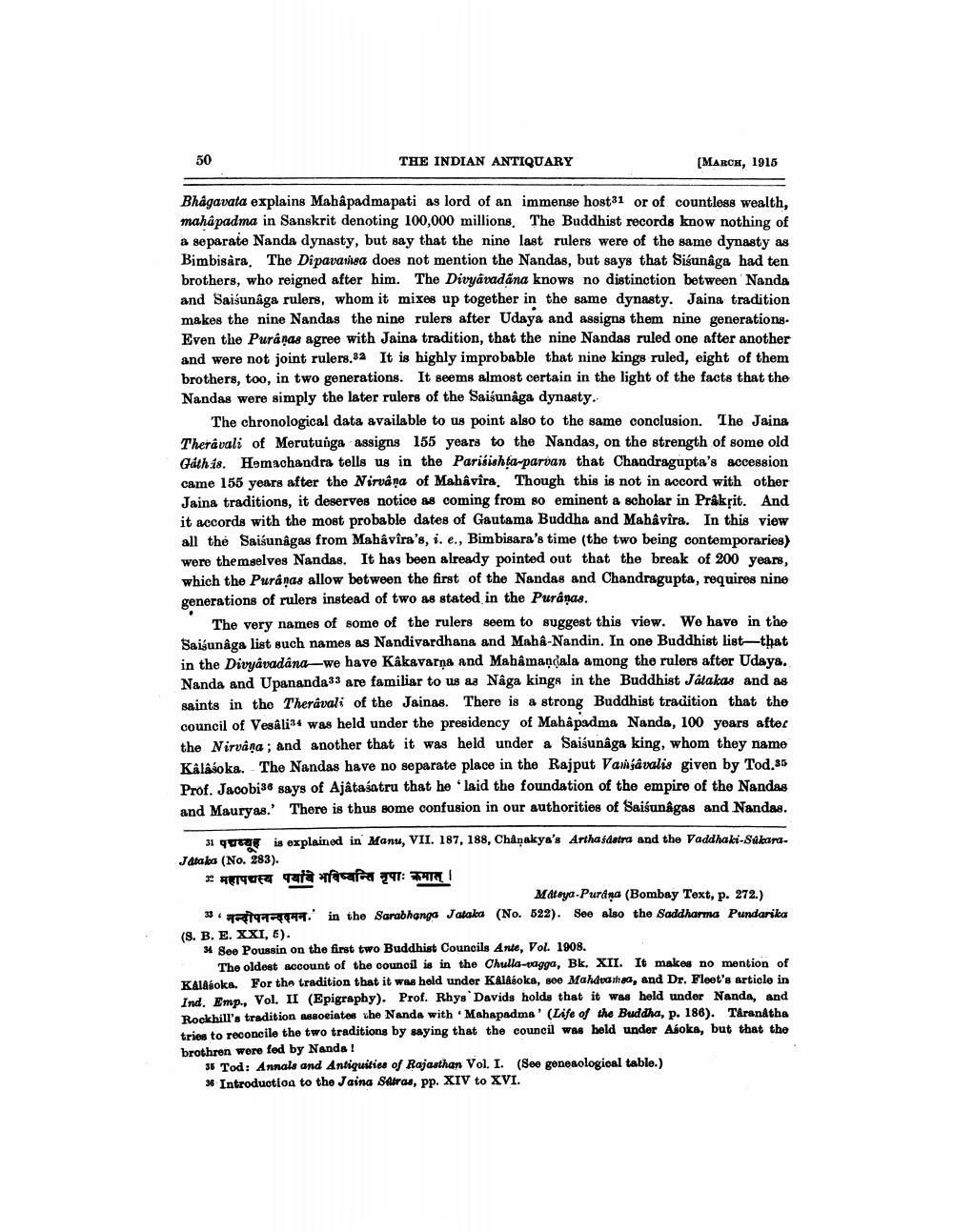________________
50
THE INDIAN ANTIQUARY
[MARCH, 1915
Bhagavata explains Mahapadmapati as lord of an immense host31 or of countless wealth, mahapadma in Sanskrit denoting 100,000 millions. The Buddhist records know nothing of a separate Nanda dynasty, but say that the nine last rulers were of the same dynasty as Bimbisára. The Dipavarsa does not mention the Nandas, but says that Sisunaga had ten brothers, who reigned after him. The Divyaradána knows no distinction between Nanda and Saiśunaga rulers, whom it mixes up together in the same dynasty. Jaina tradition makes the nine Nandas the nine rulers after Udaya and assigns them nine generations. Even the Puranas agree with Jaina tradition, that the nine Nandas ruled one after another and were not joint rulers.82 It is highly improbable that nine kings ruled, eight of them brothers, too, in two generations. It seems almost certain in the light of the facts that the Nandas were simply the later rulers of the Saišunaga dynasty.
The chronological data available to us point also to the same conclusion. The Jaina Theravali of Merutunga assigns 155 years to the Nandas, on the strength of some old Gáth is. Hemachandra tells us in the Parisishta-parvan that Chandragupta's accession came 155 years after the Nirvana of Mahavira. Though this is not in accord with other Jaina traditions, it deserves notice as coming from so eminent a scholar in Prakṣit. And it accords with the most probable dates of Gautama Buddha and Mahâvîra. In this view all the Saišunâgas from Mahavira's, i. e., Bimbisara's time (the two being contemporaries) were themselves Nandas. It has been already pointed out that the break of 200 years, which the Puranas allow between the first of the Nandas and Chandragupta, requires nine generations of rulers instead of two as stated in the Purâņas.
The very names of some of the rulers seem to suggest this view. We have in the Saisunaga list such names as Nandivardhana and Maha-Nandin. In one Buddhist list that in the Divyavadana-we have Kakavarņa and Mahâmandala among the rulers after Udaya. Nanda and Upananda33 are familiar to us as Naga kings in the Buddhist Jalakas and as saints in the Theravali of the Jainas. There is a strong Buddhist tradition that the council of Vesálish was held under the presidency of Mahapadma Nanda, 100 years after the Nirvana ; and another that it was held under a Saisunaga king, whom they name Kalásoka. The Nandas have no separate place in the Rajput Vanavalis given by Tod.85 Prof. Jacobi 36 says of Ajâtasatru that he laid the foundation of the empire of the Nandas and Mauryas. There is thus some confusion in our authorities of Saišunâgas and Nandas.
31 queer is explained in Manu, VII. 187, 188, Chåņakya's Artha sastra and the Vaddhaki-sabaraJataka (No. 283). - महापद्यस्य पर्यावे भविष्यन्ति नृपाः क्रमात् ।
Matsya Purana (Bombay Text, p. 272.) 33. 4444.' in the Sarabhanga Jataka (No. 622). See also the Saddharma Pundarika (8. B. E. XXI, 6). 34 Soe Poussin on the first two Buddhist Councils Ante, Vol. 1908.
The oldest account of the council is in the Chulla-tagga, Bk. XII. It makes no mention of KAlboka. For the tradition that it was held under Kaldboka, 800 Mahdud hea, and Dr. Fleet's article in Ind Emp. Vol. II (Epigraphy). Prof. Rhys Davids holds that it was held under Nanda, and Rockhill's tradition associates whe Nanda with Mahapadma' (Life of the Buddha, p. 186). TÁranatha tries to reconcile the two traditions by saying that the council was held under Asoka, but that the brothren wore fed by Nanda !
36 Tod: Annals and Antiquities of Rajasthan Vol. I. (See geneaological table.) 36 Introduction to the Jaina Sairas, pp. XIV to XVI.




